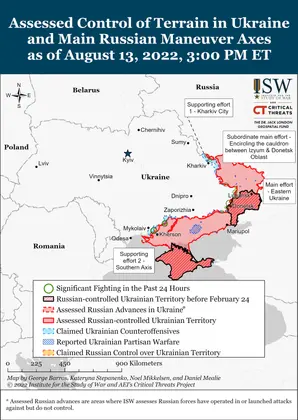Key Takeaways
- Ukrainian forces are continuing efforts to disrupt Russian ground lines of communication (GLOCs) that support Russian forces on the right bank of the Dnipro River.
- Russian forces may be reprioritizing efforts in northeastern Donetsk Oblast in order to draw Ukrainian attention away from the Southern Axis.
- Russian forces conducted limited ground attacks northwest of Slovyansk, east of Siversk, and south and east of Bakhmut.
- Russian forces conducted a limited ground assault north of Kharkiv City.
- Russian and Ukrainian authorities accused each other of shelling the Zaporizhzhia Nuclear Power Plant.
- Russian authorities are failing to pay Russian reservists and members of volunteer units for service in Ukraine.
- Russian-backed occupation authorities are likely dealing with internal challenges that are complicating efforts to administer occupation regimes and institute restoration projects in decimated areas of Donbas.
Ukrainian forces are continuing efforts to disrupt Russian ground lines of communication (GLOCs) that support Russian forces on the right bank of the Dnipro River.
JOIN US ON TELEGRAM
Follow our coverage of the war on the @Kyivpost_official.
Ukrainian forces struck the bridge on the Kakhovka Hydroelectric Power Plant (HPP) dam again on August 13, reportedly rendering the bridge unusable by heavy vehicles. Ukraine’s Southern Operational Command had previously reported on August 10 that the Kakhovka HPP dam bridge was unfit for use. The Kakhovka bridge was the only road bridge Russian forces could use following Ukrainian forces’ successful efforts to put the Antonivsky road bridge out of commission. The UK Defense Ministry has claimed that Russian forces now have no bridges usable to bring heavy equipment or supplies over the Dnipro River in Kherson Oblast and must rely mainly on the pontoon ferry they have established near the Antonivsky road bridge. ISW cannot confirm at this time whether Russian forces can use the Antonivsky rail bridge to resupply forces on the right bank of the Dnipro River.
Russian forces cannot support mechanized operations at scale without a reliable GLOC. Bringing ammunition, fuel, and heavy equipment sufficient for offensive or even large-scale defensive operations across pontoon ferries or by air is impractical if not impossible. If Ukrainian forces have disrupted all three bridges and can prevent the Russians from restoring any of them to usability for a protracted period then Russian forces on the west bank of the Dnipro will likely lose the ability to defend themselves against even limited Ukrainian counterattacks.

Kyiv Hit by Massive Drone Attack as Russian Strikes Target Multiple Ukrainian Cities
Indicators of degraded Russian supplies resulting from the disruption of Russian GLOCs over the Dnipro River would include: observed fuel and ammunition shortages among Russian forces in western Kherson Oblast; abandoned Russian vehicles; decreased intensity and, finally, cessation of Russian ground assaults and artillery attacks; possibly increased instances of Russian looting; increased reports from Russian soldiers about supply shortfalls; increased numbers of Russian prisoners of war taken by Ukrainian forces; and an observed absence of new heavy machinery transported to western Kherson. Such indicators could take days or weeks to observe depending on how much Russian forces have been able to stockpile supplies on the west bank of the Dnipro and how successful Ukrainian forces are at finding and destroying those stockpiles while keeping the bridges inoperable.
Ukrainian Mykolaiv Oblast Head Vitaly Kim reported that unspecified Russian military command elements left upper Kherson Oblast and relocated to the left bank of the Dnipro River, suggesting that the Russian military leadership is concerned about being trapped on the wrong side of the river. Ukrainian Advisor to the Minister of Internal Affairs Rostislav Smirnov also stated that Russia has deployed 90% of its air assault forces (presumably 90% of those deployed in Ukraine) to unspecified locations in southern Ukraine to augment Russian defenses or possibly prepare for Russian counteroffensives. It is unclear whether the Russian airborne units Smirnov mentioned are concentrated exclusively in Kherson Oblast or also deployed near Zaporizhia. Elements of the Russian 7th Airborne Division are known to be operating in Kherson Oblast as of at least August 10. The concentration of Russian Airborne Forces in western Kherson Oblast could indicate Russian efforts to use forces to defend against a Ukrainian counteroffensive that they are more likely to be able to exfiltrate by air if they are unable to hold the Ukrainians back or reestablish their GLOCs. Airborne forces are easier to move by aircraft than regular mechanized forces, of course, although the Russians could find it challenging and very risky to try to move forces by air given Ukrainian attacks on airfields in Kherson Oblast and Russian failure to secure air superiority.
Russian forces may be reprioritizing advances in northeastern Donetsk Oblast in order to draw attention from Ukrainian counteroffensive actions in Southern Ukraine.
Russian forces had seemingly scaled back offensive actions east of Siversk and conducted sporadic and limited ground attacks while relying heavily on artillery barrages of surrounding settlements since August 6. However, since August 11, Russian forces have increased the number of limited ground attacks in the Siversk area. These attacks, along with continued assaults in the direction of Bakhmut, may constitute an effort to draw Ukrainian materiel and personnel to the Bakhmut-Siversk line in northeastern Donetsk Oblast in order to detract Ukraine’s attention from critical areas in the South, where Ukrainian troops have been conducting effective counterattacks and may be setting conditions to launch a counteroffensive. Russian forces may hope to shift both tactical and rhetorical focus away from the south in order to alleviate pressure on their own operations along the Southern Axis. ISW will continue to monitor the situation around Siversk.
Authors: Karolina Hird, Grace Mappes, Angela Howard, George Barros, and Frederick W. Kagan
Read the full report here.
You can also highlight the text and press Ctrl + Enter






